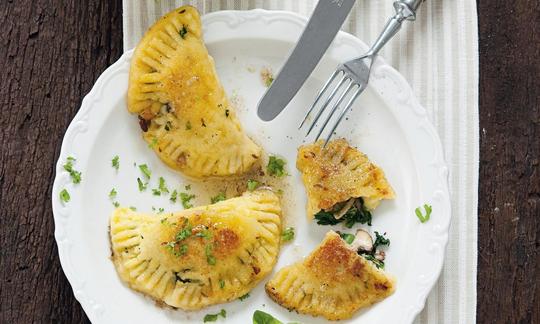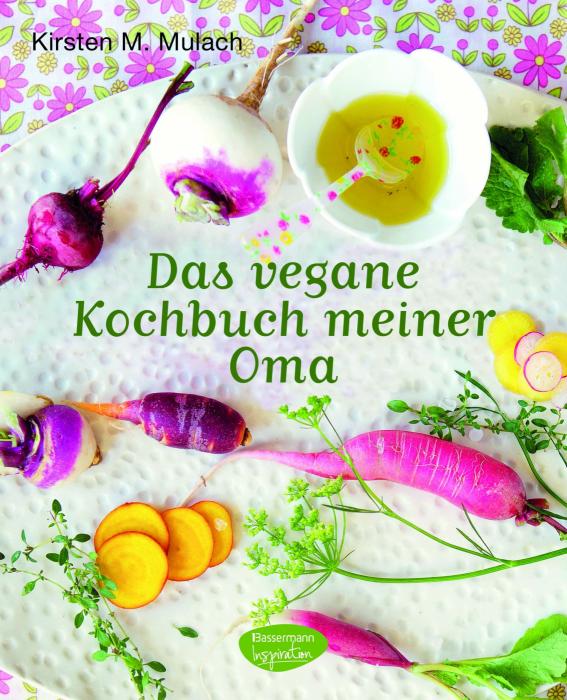Potato dumplings vegan with spinach and mushrooms (pockets)
vegan
Ingredients (for servings, )
| For the filling | |
|---|---|
| 8 ½ oz | Spinach, raw (vegetable spinach) |
| 3 ½ oz | Cultivated mushrooms, raw (organic?) |
| 1 | Onions, raw (organic?) (3.9 oz) |
| ⅓ oz | Vegetable margarine, without trans fats (organic?) |
| 1 dash | Table salt (table salt, raw?, organic?) (0.01 oz) |
| 1 dash | Black pepper (organic?, raw?) (0.00 oz) |
| 1 dash | Nutmeg, ground or grated (raw, organic?) (0.00 oz) |
| For the dough | |
| 18 oz | Jacket potatoes, cooked in salt (organic?) |
| 3 ½ oz | Wheat flour (raw?, organic?) |
| 1 tbsp | Corn starch (corn starch, organic?, raw?) (0.35 oz) |
| 1 tsp | Caraway seeds (real caraway, raw, organic?) (0.07 oz) |
| 10 sprigs | Parsley, fresh, raw (leaf parsley, parsley) (0.35 oz) |
| 1 ¾ oz | Vegetable margarine, without trans fats (organic?) |
Equipment
- potato ricer or potato masher or food mill (passe-vite)
- rolling pin
- skillet (frying pan)
- stove
Type of preparation
- fry
- sweat
- season to taste
- remove the skin
- roll out
Preparation
For the filling
Clean and wash the spinach. Clean the mushrooms, peel the onion(s), and finely chop both.Melt 10 g of the vegan butter in a skillet and sweat the onion and mushroom mixture.
The author Kirsten M. Mulach recommends the margarine brand Alsan as it doesn’t contain any soy or soy products. Alsan is also available as organic margarine: coconut oil is the main raw ingredient. In the United States, Earth Balance also offers a soy-free organic margarine.
Sauté the spinach briefly in the skillet and season to taste with salt, pepper, and nutmeg. Remove from heat and set to the side.
For the dough
Peel the potatoes, press through a potato ricer into a large bowl, and then combine with the flour, cornstarch, caraway, and the finely chopped herbs.On a floured surface, roll out the dough with a rolling pin until it is about ½ cm thick and then cut out circles that have a diameter of about 6 cm. Place a scoop of the spinach and mushroom filling onto the middle of half of the circles and then place a second circle on top. Use a fork to carefully press the edges of each pocket together.
Heat the vegan margarine in a skillet and then fry the pockets on a medium heat until they are golden brown. Drizzle the remaining oil from the skillet onto the potato pockets and serve with salad.
“My grandma set some of the basic dough aside before adding the herbs and caraway and used it to make ʽsweet pocketsʼ to serve with coffee.”
|
Nutritional Information per person
Convert per 100g
|
2000 kcal | |
|---|---|---|
| Energy | 350 kcal | 17.5% |
| Fat/Lipids | 13 g | 18.7% |
| Saturated Fats | 2.7 g | 13.4% |
| Carbohydrates (inc.dietary fiber) | 52 g | 19.2% |
| Sugars | 3.2 g | 3.5% |
| Fiber | 5.5 g | 22.0% |
| Protein/Albumin | 8.5 g | 17.0% |
| Cooking Salt (Na:534.2 mg) | 1'357 mg | 56.5% |
| Essential micronutrients with the highest proportions | per person | 2000 kcal | |
|---|---|---|---|
| Vit | Vitamin K | 316 µg | 422.0% |
| Vit | Vitamin B9, B11 (Folate, as the active form of folic acid) | 156 µg | 78.0% |
| Sodium, Na | 534 mg | 67.0% | |
| Vit | Vitamin A, as RAE | 427 µg | 53.0% |
| Elem | Potassium, K | 995 mg | 50.0% |
| Min | Manganese, Mn | 1.00 mg | 50.0% |
| Vit | Vitamin C (ascorbic acid) | 40 mg | 50.0% |
| Min | Copper, Cu | 0.46 mg | 46.0% |
| Prot | Tryptophan (Trp, W) | 0.11 g | 45.0% |
| Vit | Vitamin B6 (pyridoxine) | 0.57 mg | 41.0% |
Detailed Nutritional Information per Person for this Recipe
The majority of the nutritional information comes from the USDA (US Department of Agriculture). This means that the information for natural products is often incomplete or only given within broader categories, whereas in most cases products made from these have more complete information displayed.
If we take flaxseed, for example, the important essential amino acid ALA (omega-3) is only included in an overarching category whereas for flaxseed oil ALA is listed specifically. In time, we will be able to change this, but it will require a lot of work. An “i” appears behind ingredients that have been adjusted and an explanation appears when you hover over this symbol.
For Erb Muesli, the original calculations resulted in 48 % of the daily requirement of ALA — but with the correction, we see that the muesli actually covers >100 % of the necessary recommendation for the omega-3 fatty acid ALA. Our goal is to eventually be able to compare the nutritional value of our recipes with those that are used in conventional western lifestyles.
| Essential fatty acids | per person | 2000 kcal |
|---|---|---|
| Linoleic acid; LA; 18:2 omega-6 | 3.2 g | 32.0% |
| Alpha-Linolenic acid; ALA; 18:3 omega-3 | 0.34 g | 17.0% |
| Essential amino acids | per person | 2000 kcal |
|---|---|---|
| Tryptophan (Trp, W) | 0.11 g | 45.0% |
| Threonine (Thr, T, irreversibly transaminated) | 0.29 g | 31.0% |
| Isoleucine (Ile, I) | 0.34 g | 27.0% |
| Valin (Val, V) | 0.44 g | 27.0% |
| Phenylalanine (Phe, F) | 0.38 g | 24.0% |
| Leucine (Leu, L) | 0.55 g | 23.0% |
| Lysine (Lys, K, irreversibly transaminated) | 0.37 g | 20.0% |
| Methionine (Met, M) | 0.14 g | 15.0% |
| Vitamins | per person | 2000 kcal |
|---|---|---|
| Vitamin K | 316 µg | 422.0% |
| Vitamin B9, B11 (Folate, as the active form of folic acid) | 156 µg | 78.0% |
| Vitamin A, as RAE | 427 µg | 53.0% |
| Vitamin C (ascorbic acid) | 40 mg | 50.0% |
| Vitamin B6 (pyridoxine) | 0.57 mg | 41.0% |
| Vitamin B1 (Thiamine) | 0.24 mg | 22.0% |
| Vitamin B3 (Niacin) | 3.5 mg | 22.0% |
| Vitamin B5 (Pantothenic acid) | 1.2 mg | 21.0% |
| Vitamin B2 (Riboflavin) | 0.28 mg | 20.0% |
| Vitamin B7 (Biotin, ex vitamin H) | 9.5 µg | 19.0% |
| Vitamin E, as a-TEs | 1.9 mg | 16.0% |
| Vitamin D | 0.05 µg | 1.0% |
| Vitamin B12 (Cobalamin) | 0.01 µg | < 0.1% |
| Essential macroelements (macronutrients) | per person | 2000 kcal |
|---|---|---|
| Sodium, Na | 534 mg | 67.0% |
| Potassium, K | 995 mg | 50.0% |
| Magnesium, Mg | 91 mg | 24.0% |
| Phosphorus, P | 148 mg | 21.0% |
| Calcium, Ca | 91 mg | 11.0% |
| Essential trace elements (micronutrients) | per person | 2000 kcal |
|---|---|---|
| Manganese, Mn | 1.00 mg | 50.0% |
| Copper, Cu | 0.46 mg | 46.0% |
| Selenium, Se | 14 µg | 25.0% |
| Iron, Fe | 2.7 mg | 20.0% |
| Zinc, Zn | 1.2 mg | 12.0% |
| Iod, I (Jod, J) | 12 µg | 8.0% |
| Fluorine, F | 62 µg | 2.0% |
Südwest-Verlag München / Bassermann / Irisiana Verlagsgruppe Random House GmbH, Kirsten M. Mulach
Raw recipes 6, Cooked recipes 55 (4)
Additional photos (10)
In "My Grandma's Vegan Cookbook," Kirsten M. Mulach presents particularly natural vegan recipes for all seasons and times of day.
Since this book is written in German, a description is omitted here. If you are interested, please switch to German in the menu.
These vegan potato dumplings (pockets) have a spinach and mushroom filling and are made with potatoes that have been cooked in advance.
General information about Maultaschen: Maultaschen are a traditional specialty in Swabian cuisine. They are pockets made of pasta dough and filled with a basic mixture of sausage meat, spinach, onions, and bread crumbs. They are very likely the Swabian version of more well-known Italian pastas such as ravioli and tortellini. The spinach filling is reminiscent of its Italian origin as is the fact that you find Walsertorten (Waldensian cakes) in Maulbronn, a city in the northern part of Baden-Württemberg, since Waldensians were Protestant religious refugees from northern Italy. Maultaschen are also available as sweet desserts.
Additional information: From Wikipedia: “Maultaschen are similar to the Italian ravioli but are typically larger in size—each Maultasche being approximately 8–12 centimeters (3–5 inches across). They are almost invariably square or rectangular in shape. On 22 October 2009, the European Union recognized Maultaschen (Schwäbische Maultaschen or Schwäbische Suppenmaultaschen) as a "regional specialty" and remarked that the dish is significant to the cultural heritage of Baden-Württemberg. This measure provides protection to the integrity of the dish, mandating that genuine Maultaschen are only produced in Swabia, a historical region that was incorporated into the modern German states of Baden-Württemberg and Bavaria.”
Important for the flavor: Make sure to use young spinach and freshly ground pepper. The boiled potatoes should be completely cold before they are put through the potato ricer. The author’s grandmother preferred darker varieties of potatoes. You should use an all-purpose white flour (type 550).
Alternative kitchen utensils: Instead of using a potato masher, potato pestle masher, potato ricer, or pastry cutter, you can also use a food mill or a handheld electric mixer.
Preparing boiled potatoes in their jackets: Place starchy potatoes in a saucepan with unsalted water so that they are just covered and then boil for about 15 to 20 minutes until tender. You can stick them with a fork or knife to see if they are done. If there is almost no resistance and it falls back into the water on its own, the potatoes are most likely done. Drain and then let cool. The potatoes should be cold before you peel them. You can use cold water to cool them more quickly, and then the skins will also come off more easily.




